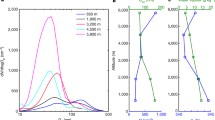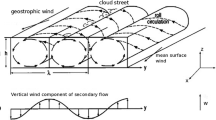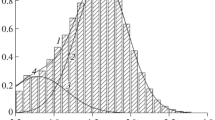Abstract—
An investigation into mesoscale roll circulation and its transport characteristics in the atmospheric boundary layer (ABL) is carried out. The case study of July 28, 2007, in Kalmykia, monitored during an expedition from the Obukhov Institute of Atmospheric Physics, is considered using the WRF-ARW model. The development of circulation with considerable asymmetry in the positive and negative components of the velocity field and helicity is recorded. The quasi-2D roll structures are characterized by an intensification of the dust capture and accumulation from the underlying terrain and, along with intensive vortices with a vertical axis, are a significant source of atmospheric impurities. Captured finely dispersed aerosols can be transported at long distances and form aerosol layers.












Similar content being viewed by others
REFERENCES
J. Wurman and J. Winslow, “Intense sub-kilometer-scale boundary layer rolls observed in Hurricane Fran,” Science 280 (5363), 555–557 (1998).
S. H. Chou and M. P. Ferguson, “Heat fluxes and roll circulations over the western Gulf Stream during an intense cold-air outbreak,” Boundary Layer Meteorol. 55 (3), 255–281 (1991).
A. E. Ordanovich and Yu. V. Pashkovskaya, “Effect of thermal stratification on Ekman flow stability,” Fluid Dyn. 33 (3), 355–359 (1998).
R. E. Kaylor and A. Faller, “Instability of the Stratified Ekman Boundary Layer and the Generation of Internal Waves,” J. Atmos. Sci. 29 (3), 497–509 (1972).
I. G. Granberg, V. F. Kramar, R. D. Kuznetsov, O. G. Chkhetiani, M. A. Kallistratova, S. N. Kulichkov, M. S. Artamonova, D. D. Kuznetsov, V. G. Perepelkin, V. V. Perepelkin, and F. A. Pogarskii, “A study of the spatial structure of the atmospheric boundary layer with a Doppler-Sodar network,” Izv., Atmos. Ocean. Phys. 45 (5), 541–548 (2009).
D. Etling and R. A. Brown, “Roll vortices in the planetary boundary layer. A review,” Boundary-Layer Meteorol. 65 (3), 215–248 (1993).
R. A. Brown, “Longitudinal instabilities and secondary flows in the planetary boundary layer,” Rev. Geophys. Space Phys. 18 (3), 683–697 (1980).
R. Foster, “Signature of large aspect ratio roll vortices in synthetic aperture radar images of tropical cyclones,” Oceanography 26 (2), 58–67 (2013).
S. H. Chou and D. Atlas, “Satellite estimates of ocean–air heat fluxes during cold air outbreaks,” Mon. Weather Rev. 110 (10), 1434–1450 (1982).
P. F. Hein and R. A. Brown, “Observations of longitudinal roll vortices during arctic cold air outbreaks over open water,” Boundary-Layer Meteorol. 45 (1–2), 177–199 (1988).
B. Brümmer, “Roll and cell convection in wintertime Arctic cold-air outbreaks,” J. Atmos. Sci. 56 (15), 2613–2636 (1999).
R. C. Foster, “Structure and energetics of optimal Ekman layer perturbations,” J. Fluid Mech. 333, 97–123 (1997).
H. Morrison, J. A. Curry, and V. I. Khvorostyanov, “A new double-moment microphysics parameterization for application in cloud and climate models. Part I: description,” J. Atmos. Sci. 62 (6), 1665–1677 (2005).
R. C. Foster, “Why rolls are prevalent in the hurricane boundary layer,” J. Atmos. Sci. 62 (8), 2647–2661 (2005).
I. Ginis, A. P. Khain, and E. Morozovsky, “Effects of large eddies on the structure of the marine boundary layer under strong wind conditions,” J. Atmos. Sci. 72 (9), 3049–3063 (2004).
K. Gao and I. Ginis, “On the equilibrium-state roll vortices and their effects in the hurricane boundary layer,” J. Atmos. Sci. 73 (3), 1205–1222 (2016).
J. Ito, T. Oizumi, and H. Niino, “Near-surface coherent structures explored by large eddy simulation of entire tropical cyclones,” Sci. Rep. 7 (1), 3798 (2017).
K. A. Gavrilov, D. Morvan, G. Accary, D. V. Lyubimov, S. Meradji, and O. A. Bessonov, “Numerical modeling of coherent structures attendant on impurity propagation in the atmospheric boundary layer over a forest canopy,” Vychisl. Mekh. Sploshnykh Sred 3 (2), 34–45 (2010).
D. K. Lilly, “On the stability of Ekman boundary flow,” J. Atmos. Sci. 23 (5), 481–494 (1966).
R. C. Foster, PhD Thesis (University of Washington, Seattle, 1996).
R. A. Brown, “A secondary flow model for the planetary boundary layer,” J. Atmos. Sci. 27 (5), 742–757 (1970).
L. A. Mikhailova and A. E. Ordanovich, “Simulation of two-dimensional ordered vortices in the atmospheric boundary layer,” Meteorol. Gidrol., No. 11, pp. 29–42.
D. J. Stensrud and H. N. Shirer, “Development of boundary layer rolls from dynamic instabilities,” J. Atmos. Sci. 45 (6), 1007–1019 (1988).
T. Dubos, C. Barthlott, and P. Drobinski, “Emergence and secondary instability of Ekman layer rolls,” J. Atmos. Sci. 65 (7), 2326–2342 (2008).
N. V. Vazaeva, O. G. Chkhetiani, L. V. Shestakova, and L. O. Maksimenkov, “Nonlinear evolution of structures in the Ekman layer,” Vychisl. Mekh. Sploshnykh Sred 10 (2), 197–211 (2017).
G. N. Coleman, J. H. Ferziger, and P. R. Spalart, “A numerical study of the turbulent Ekman layer,” J. Fluid Mech. 213, 313–348 (1990).
G. N. Coleman, J. H. Ferziger, and P. R. Spalart, “A numerical study of the convective boundary layer,” Boundary-Layer Meteorol. 70 (3), 247–272 (1994).
J. W. Deardorff, “Numerical investigation of neutral and unstable planetary boundary layers,” J. Atmos. Sci. 29 (1), 91–115 (1972).
P. Mason and D. Thomson, “Large-eddy simulations of the neutral-static-stability planetary boundary layer,” Q. J. R. Meteorol. Soc. 113, 413–443 (1987).
S. T. Salesky, M. Chamecki, and E. Bou-Zeid, “On the nature of the transition between roll and cellular organization in the convective boundary layer,” Boundary Layer Meteorol. 163 (1), 41–68 (2017).
C. H. Moeng, J. Dudhia, J. Klemp, and P. Sullivan, “Examining two-way grid nesting for large eddy simulation of the PBL using the WRF model,” Mon. Weather Rev. 135 (6), 2295–2311 (2007).
J. Ito, H. Niino, and M. Nakanishi, “Large eddy simulation on dust suspension in a convective mixed layer,” Sci. Online Lett. Atmos. 6 (1), 133–136 (2010).
J. Ching, R. Rotunno, M. LeMone, A. Martilli, B. Kosovic, P. A. Jimenez, and J. Dudhia, “Convectively induced secondary circulations in fine-grid mesoscale numerical weather prediction models,” Mon. Weather Rev. 142 (9), 3284–3302 (2014).
Y. Zhang, R. Hu, and X. Zheng, “Large-scale coherent structures of suspended dust concentration in the neutral atmospheric surface layer: A large-eddy simulation study,” Phys. Fluids 30 (4), 046601 (2018).
C.-L. Lin, J. McWilliams, C. -H. Moeng, and P. Sullivan, “Coherent structures and dynamics in a neutrally stratified planetary boundary layer flow,” Phys. Fluids 8, 2626–2639 (1996).
P. Drobinski, P. Carlotti, J.-L. Redelsperger, R. Banta, V. Masson, and R. Newsom, “Numerical and experimental investigation of the neutral atmospheric surface layer,” J. Atmos. Sci. 64 (1), 137–156 (2007).
K. Hibino, H. Ishikawa, and K. Ishioka, “Effect of a cap** inversion on the stability of an Ekman boundary layer,” J. Meteorol. Soc. Jpn. Ser. II 90 (2), 311–319 (2012).
D. Etling, “Some aspect of helicity in atmospheric flows,” Beitr. Phys. Atmos. 58 (1), 88–100 (1985).
M. V. Kurganskii, “On the relation between helicity and potential vorticity in a compressible rotating fluid,” Izv. Akad. Nauk: Fiz. Atmos. Okeana 25 (12), 1326–1329 (1989).
R. Hide, “Superhelicity, helicity and potential vorticity,” Geophys. Astrophys. Fluid Dyn. 48 (1–3), 69–79 (1989).
O. G. Chkhetiani, “On the helical structure of the Ekman boundary layer,” Izv., Atmos. Ocean. Phys. 37 (5), 569–575 (2001).
B. M. Koprov, V. M. Koprov, V. M. Ponomarev, and O. G. Chkhetiani, “Experimental studies of turbulent helicity and its spectrum in the atmospheric boundary layer,” Dokl. Phys. 50 (8), 419–422 (2005).
N. V. Vazaeva, O. G. Chkhetiani, R. D. Kuznetsov, M. A. Kallistratova, V. F. Kramar, V. S. Lyulyukin, and D. D. Kuznetsov, “Estimating helicity in the atmospheric boundary layer from acoustic sounding data,” Izv., Atmos. Ocean. Phys. 53 (2), 174–186 (2017).
E. Deusebio and E. Lindborg, “Helicity in the Ekman Boundary Layer,” J. Fluid Mech. 755, 654–671 (2014).
O. G. Chkhetiani, M. V. Kurgansky, and N. V. Vazaeva, “Turbulent helicity in the atmospheric boundary layer,” Boundary Layer Meteorol. 168 P, 361–385 (2018).
V. M. Ponomarev, “Micro-scale modelling of pollution dispersion in atmospheric boundary layer,” Syst. Anal. Model. Simul. 30, 39–44 (1998).
G. I. Gorchakov, B. M. Koprov, and K. A. Shukurov, “Arid aerosol transport by vortices,” Izv., Atmos. Ocean. Phys, 39 (5), 596–608 (2003).
R. V. Cakmur, R. L. Miller, and O. Torres, “Incorporating the effect of small-scale circulations upon dust emission in an atmospheric general circulation model,” J. Geophys. Res. 109 (D7) (2004).
T. Takemi, M. Yasui, J. Zhou, and L. Liu, “Role of boundary layer and cumulus convection on dust emission and transport over a midlatitude desert area,” J. Geophys. Res. 111 (D11), D11203 (2006).
J. H. Marsham, D. J. Parker, C. M. Grams, B. T. Johnson, W. M. F. Grey, and A. N. Ross, “Observations of mesoscale and boundary-layer scale circulations affecting dust transport and uplift over the Sahara,” Atmos. Chem. Phys. 8, 6979–6993 (2008).
M. Klose and Y. Shao, “Stochastic parameterization of dust emission and application to convective atmospheric conditions,” Atmos. Chem. Phys. Discuss. 12, 3263–3293 (2012).
R. A. Bagnold, The Physics of Blown Sand and Desert Dunes (Methuen, London, 1941).
Y. Shao, Physics and Modelling of Wind Erosion (Kluwer, Boston, 2000).
N. E. Zhukovskii, “On snow drifts and river silting,” in Collection of Works in 7 Volumes (GTTI, Moscow–Leningrad, 1949), vol. 3, pp. 451–477 [in Russian].
M. R. Maxey, “On the advection of spherical and non-spherical particles in a non-uniform flow,” Phil. Trans. R. Soc. London A 333 (1631), 289–307 (1990).
L. A. Ostrovskii, “Dynamics of the concentration of light and heavy particles in fluid flows,” Izv. Ross. Akad. Nauk, Fiz. Atmos. Okeana 26 (12), 1307–1314 (1992).
N. Raju and E. Meiburg, “Dynamics of small, spherical particles in vortical and stagnation point flow fields,” Phys. Fluids 9 (2), 299–314 (1997).
C. Narayanan, D. Lakehal, L. Botto, and A. Soldati, “Mechanisms of particle deposition in a fully developed turbulent open channel flow,” Phys. Fluids 15 (3), 763–775 (2003).
I. Mezić, A. Leonard, and S. Wiggins, “Regular and chaotic particle motion near a helical vortex filament,” Phys. D (Amsterdam) 111 (1–4), 179–201 (1998).
A. E. Aloyan, Modeling the Dynamics and Kinetics of Gaseous Admixtures and Aerosols in the Atmosphere (Nauka, Moscow, 2008) [in Russian].
S. V. Lutsenko, V. I. Lebedev, and V. N. Lykosov, “Modeling the soil aerosol transport processes in the convective boundary layer of the atmosphere,” in Proceedings of the Int. Conf. “Physics of Atmospheric Aerosol” Commemorating G. V. Rozenberg’s 85th Anniversary (Moscow, 1999), p. 216.
T. Ju, X. Li, H. Zhang, X. Cai, and Y. Song, Comparison of two different dust emission mechanisms over the Horqin Sandy Land area: Aerosols contribution and size distributions, Atmos. Environ. 176, 82–90 (2018).
IPCC IV: Climate Change 2007: The Physical Science Basis (Cambridge Univ. Press, New York, 2007).
K. Ya. Kondrat’ev and L. S. Ivlev, Aerosol Climatology and Cloudiness (VVM, St. Petersburg, 2008) [in Russian].
P. Knippertz and J.-B. W. Stuut, Mineral Dust: A Key Player in the Earth System (Springer, Dordrecht, 2014).
W. C. Skamarock, J. B. Klemp, J. Dudhia, D. O. Gill, D. M. Barker, W. Wang, and J. G. Powers, A Description of the Advanced Research WRF Version 3, NCAR Tech. Note NCAR/TN-475+STR, 2008.
N. F. Vel’tishchev and V. D. Zhupanov, “Numerical weather forecast by WRF-ARW and WRF-NMM nonhydrostatic community models,” in 80 Years of the Russian Hydrometeorological Center, Collection of Papers (Triada, Moscow, 2010), pp. 94–135 [in Russian].
C. Talbot, E. Bou-Zeid, and J. Smith, “Nested mesoscale large-eddy simulations with WRF: Performance in real test cases,” J. Hydrometeorol. 13 (5), 1421–1441 (2012).
G. A. Grell, S. E. Peckham, R. Schmitz, S. A. McKeen, G. Frost, W. C. Skamarock, B. Eder, “Fully coupled “online” chemistry within the WRF model,” Atmos. Environ. 39 (37), 6957–6975 (2005).
Y. Shao, “A Model for Mineral Dust Emission,” Journal of Geophysical Research: Atmospheres 106 (D17), 20239–20254 (2001).
Y. Shao, “Simplification of a dust emission scheme and comparison with data,” J. Geophys. Res.: Atmos. 109 (D10), D10202 (2004).
Y. Shao, M. Ishizuka, M. Mikami, and J. Leys, “Parameterization of size-resolved dust emission and validation with measurements,” J. Geophys. Res.: Atmos. 116 (D8), D08203 (2011).
L. Wei and Q. Chen, “Calculation of drag force on an object settling in gas-solid fluidized beds,” Part. Sci. Technol. 19 (3), 229–238 (2001).
G. S. Golitsyn, I. G. Granberg, A. V. Andronova, V. M. Ponomarev, S. S. Zilitinkevich, V. V. Smirnov, and M. Y. Yablokov, “Investigation of boundary layer fine structure in arid regions: Injection of fine dust into the atmosphere,” Water, Air, Soil Pollut.: Focus 3 (2), 245–257 (2003).
E. B. Gledzer, I. G. Granberg, and O. G. Chkhetiani, “Air dynamics near the soil surface and convective emission of aerosol,” Izv., Atmos. Ocean. Phys. 46 (1), 29–40 (2010).
N. V. Vazaeva, O. G. Chkhetiani, E. B. Gledzer, M. S. Artamonova, M. A. Iordanskii, M. V. Kurgansky, V. A. Lebedev, L. O. Maximenkov, and Y. I. Obvintsev, “Aerosol emission in the arid zones of Southern Russia,” in Report Series In Aerosol Science 201: Proceedings of the 3rd Pan-Eurasian Experiment (PEEX) Conference and the 7th PEEX Meeting (Helsinki, 2017), pp. 518–520.
ACKNOWLEDGMENTS
This work was supported by the Russian Foundation for Basic Research, project nos. 18-35-00600 and 17-05-01116, as well as by Programs of Fundamental Research of the Presidium of the Russian Academy of Sciences nos. 28 and 51.
Author information
Authors and Affiliations
Corresponding author
Additional information
Translated by L. Mukhortova
Rights and permissions
About this article
Cite this article
Vazaeva, N.V., Chkhetiani, O.G. & Maksimenkov, L.O. Organized Roll Circulation and Transport of Mineral Aerosols in the Atmospheric Boundary Layer. Izv. Atmos. Ocean. Phys. 55, 152–166 (2019). https://doi.org/10.1134/S0001433819020142
Received:
Revised:
Accepted:
Published:
Issue Date:
DOI: https://doi.org/10.1134/S0001433819020142




